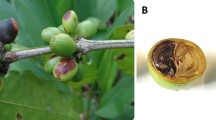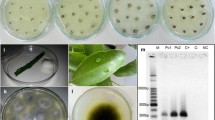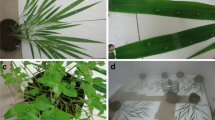Abstract
On the maturing bark of cut branches ofCoffea arabica previously sprayed with copper fungicides perithecia ofGlomerella cingulata were easily found after two to ten days of incubation. Without fungicides the number of perithecia was decidedly lower. On prunings left on the ground under the coffee trees for 6 to 24 weeks the perithecia could also be found, but the numbers declined rapidly with time.
Perithecia ofG. cingulata could forcibly discharge ascospores under laboratory conditions. Monospore cultures obtained by catching ascospores on agar, invariably belonged to threeColletotrichum types. It was rarely possible to isolate aColletotrichum able to infect green coffee berries. Growthrate, colour of the mycelium, number of conidia producedin vitro and infectivity on green coffee berries, however, differed substantially fromC. coffeanum, the cause of coffee berry disease.
In Kenya no evidence has been obtained that ascospores from perithecia on bark could infect wounded or unwounded green coffee berries. Neither has any infection been obtained with ascospores from perithecia grownin vitro. Possible explanations for the difference with previous findings are offered. Based on the data presented in this paper, it is concluded thatG. cingulata is not likely to play a role in the epidemiology of the coffee berry disease in Kenya.
Similar content being viewed by others
References
Bock, K. R., 1956. Investigations on coffee berry disease. Laboratory studies. E. Afr. agric. J. 22 97–103.
Boisson, C., 1960. L’anthracnose du Caféier. Revue Mycol. 25: 263–292.
Gibbs, J. N., 1969. Inoculum sources for coffee berry disease. Ann. appl. Biol. 64: 515–522.
Hindorf, H., 1970.Colletotrichum spp. isolated fromCoffee arabica L. in Kenya (in press).
Hocking, D., Johanns, J. C. & Vermeulen, H., 1967. Ascospore production, discharge and infection byGlomerella cingulata causing coffee berry disease. Nature, Lond. 214: 1144–1145.
Ingold, C. T., 1965. Spore Liberation. Clarendon Press, Oxford.
Kaiser, W. J. & Lukezic, F. L., 1966. Occurrence, sporulation and pathogenicity studies withGlomerella cingulata associated with Crown rot of boxed bananas. Mycologia, 58: 397–405.
Macdonald, J., 1926. A preliminaryaccount of a disease of green coffee berries in Kenya. Colony. Trans. mycol. Soc. 11: 145–154.
Meiffren, M., 1957. Les maladies du Caféier en Côte d’Ivoire. Centre Rech. agron. Bingerville: 67–72.
Nutman, F. J. & Roberts, F. M., 1961. Investigations on a disease ofCoffea arabica caused by a form ofColletotrichum coffeanum Noack. III. The relation between infection of bearing wood and disease incidence. Trans. Br. mycol. Soc. 44: 511–521.
Nutman, F. J. & Roberts, F. M., 1969. The stimulating effect of some fungicides onGlomerella cingulata in relation to the control of coffee berry disease. Ann. appl. Biol. 64: 335–344.
Small, W., 1926. On the occurrences of a species ofColletotrichum. Trans. Br. mycol. Soc. 11: 112–137.
Vermeulen, H., 1970. Coffee berry disease in Kenya. I.Colletotrichum spp. colonizing the bark ofCoffea arabica L. Neth. J. Pl. Path. 76: 277–284.
Author information
Authors and Affiliations
Rights and permissions
About this article
Cite this article
Vermeulen, H. Coffee berry disease in Kenya. II. The role of Glomerella cingulata in the Colletotrichum population, colonizing the bark of Coffea arabica. Neth. J. Pl. Path. 76, 285–292 (1970). https://doi.org/10.1007/BF03041358
Accepted:
Issue Date:
DOI: https://doi.org/10.1007/BF03041358




